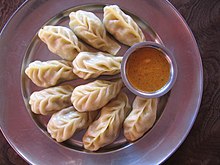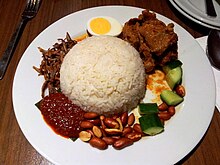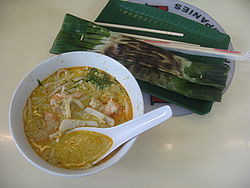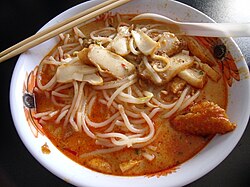与其战战兢兢地害怕不开心的到来
不如现在开开心心,
能开心多久,就多久。
=)
Wednesday, December 5, 2012
Tuesday, December 4, 2012
Monday, November 26, 2012
Monday, November 5, 2012
Thursday, October 18, 2012
Tuesday, October 16, 2012
Sunday, October 14, 2012
NIKE Run!
13/10/12 We Run KL !
早前,朋友就问我要不要参加马拉松。
那时的我,很期待参加但却抱着战战兢兢的心情。
毕竟,这是我第一次参加10公里的马拉松比赛。
从照片里可见,这次是由出名的运动品牌NIKE所主办。
所有的参赛者都可以获得一个race kit,里面有NIKE的水瓶和衣服。
不错不错 =)
比赛在下午5.30pm 开始进行。
我们在Start Line那里,等了也差不多有一个小时多。
人潮多到可以用蚂蚁来形容。
一路上跑的时候,都很享受和珍惜每一刻的时光。
有时在想,有些经历和回忆,只有特别的人才能和你一起拥有。
跑呀跑呀,突然发觉我自己已经喜欢上了马拉松。
只不过,要有朋友一起跑,才精彩。
因为一路上,很多很好笑的场面出现。也因为,
我这个朋友太过sakai了。 哈哈哈.....
其实,我们的Start Line 在 KLCC (Jalan Ampang) 附近。
Finish Line 却在Padang Merbok。最可怕的是,
当天下了一场大雨,终点站那里一片泥林。
我们的鞋都遭殃了 =(
可惜因为某种原因,我们拉长了我们的时间来完成比赛。
不过没关系,我们还是达到了我们原定的目标,
就是领到这件FINISHER T-Shirt 哈哈哈哈!
我很珍惜这次的比赛,不但只因我的运动细胞,
而且是那份独一无二的友谊。 =)
早前,朋友就问我要不要参加马拉松。
那时的我,很期待参加但却抱着战战兢兢的心情。
毕竟,这是我第一次参加10公里的马拉松比赛。
从照片里可见,这次是由出名的运动品牌NIKE所主办。
所有的参赛者都可以获得一个race kit,里面有NIKE的水瓶和衣服。
不错不错 =)
比赛在下午5.30pm 开始进行。
我们在Start Line那里,等了也差不多有一个小时多。
人潮多到可以用蚂蚁来形容。
 |
| 这只是我前面的画面,我身后可还有更多的人潮。 |
 |
| 这是我独一无二的战衣,因为每位参赛者的衣服号码都是不同的。 |
 |
| 这个是wrist band 和 D-Tag。D-Tag 是用来计算你所用的时间。 |
 |
| My partner for the whole run =) |
 |
| <3> |
 |
| #082404 #084055 |
 |
| Our D-Tag |
一路上跑的时候,都很享受和珍惜每一刻的时光。
有时在想,有些经历和回忆,只有特别的人才能和你一起拥有。
跑呀跑呀,突然发觉我自己已经喜欢上了马拉松。
只不过,要有朋友一起跑,才精彩。
因为一路上,很多很好笑的场面出现。也因为,
我这个朋友太过sakai了。 哈哈哈.....
其实,我们的Start Line 在 KLCC (Jalan Ampang) 附近。
Finish Line 却在Padang Merbok。最可怕的是,
当天下了一场大雨,终点站那里一片泥林。
我们的鞋都遭殃了 =(
 |
| My FINISHER T-shirt!! |
不过没关系,我们还是达到了我们原定的目标,
就是领到这件FINISHER T-Shirt 哈哈哈哈!
我很珍惜这次的比赛,不但只因我的运动细胞,
而且是那份独一无二的友谊。 =)
Thursday, September 27, 2012
得奖啦!
Saturday, September 15, 2012
Wednesday, September 12, 2012
放下
Time proved me, it isn't the person who change but it is the perception of our heart changed.
短短的几个月,我领悟到这个道理。
原来我们彼此,早已发现大家都变了。
从前的那份感觉已不再。
我很努力地想维持这份贵重的情谊。
可是逐渐地发觉,是不是只有我一个人在努力?
还是只有我一个人一厢情愿地想停留在从前的美好时光?
或许是这几个月,见过的经历过的,体会过的
也为此哭了好几次,
终于,我明白了成长总在泪后。
就连我自己也惊讶,那奇妙的冷眼对待竟然在我身上发生。
我不再看重,只求自己得到自己心里的平衡。
学习爱自己多一些,为自己多着想一些,
这样生活才会舒服一点。
虽然自己心中的原则还是不变,
但是那么多次的例子,证明了万事不能强求。
只求自己心中的平静。
如今的我,懂得谁在我心目中才是扮演重要的角色。
感谢他一路一来的陪伴,在我身边支持我。
如今我回头看,过往的时光固然开心
但是也充满了泪水。
虽然现在的日子比较平淡,但是心里轻松了很多。
因为,我学习着放下。
*还是老话一句,我没事。写得出这篇证明我已经想通了。要说,我自然会说。
=)
短短的几个月,我领悟到这个道理。
原来我们彼此,早已发现大家都变了。
从前的那份感觉已不再。
我很努力地想维持这份贵重的情谊。
可是逐渐地发觉,是不是只有我一个人在努力?
还是只有我一个人一厢情愿地想停留在从前的美好时光?
或许是这几个月,见过的经历过的,体会过的
也为此哭了好几次,
终于,我明白了成长总在泪后。
就连我自己也惊讶,那奇妙的冷眼对待竟然在我身上发生。
我不再看重,只求自己得到自己心里的平衡。
学习爱自己多一些,为自己多着想一些,
这样生活才会舒服一点。
虽然自己心中的原则还是不变,
但是那么多次的例子,证明了万事不能强求。
只求自己心中的平静。
如今的我,懂得谁在我心目中才是扮演重要的角色。
感谢他一路一来的陪伴,在我身边支持我。
如今我回头看,过往的时光固然开心
但是也充满了泪水。
虽然现在的日子比较平淡,但是心里轻松了很多。
因为,我学习着放下。
*还是老话一句,我没事。写得出这篇证明我已经想通了。要说,我自然会说。
=)
Thursday, August 16, 2012
结束了大学第一年
很开心地说,我终于考完试了!
现在正处于放semester break的时段。
也意味着,我完成了我的第一年大学生涯。
时间中是那么快。
在这一年里,发生了大大小小的事情。
每一段故事,都为我留下了不同的回忆。
一年了,我们之间的友情
也不再像开学第一天那般,彬彬有礼
那么拘谨,
如今的我们,是一起读书,一起奋斗,
一起分享,一起欢笑,一起流泪
那样般的精神支柱。
没了你们这班大学朋友,我的大学第一年
不会那么色彩,不会那么黑白。
你们,让我在故事中成长。
从你们身上,我看到了不同的想法。
没有你们的出现,我也找不到我的幸福。
也是你们,让我对每一天都充满期待。
在这一年里,读书的压力只有增无减。
读书后一起停息,是我最爱的事。
考试期间那种非人的生活,
如今要等到终于有得停歇下来后,才觉得值得细细回味。
虽然忙碌,辛苦
但我可以很理直气壮地说,我的大学生活过得很充实!
如今放暑假,每个人最兴奋的就是可以回家乡。
回到家,才深深体会远在他乡
倦鸟归槽的感觉。
是时候,让那疲惫的自己
好好地休息,充电吧。
我一直以来,都很惊叹为何时间总是过得那么快。
我的大学生活,也只剩下两年的时间罢了。
在接下来的日子,要过怎么样的生活
那就要看我们自己的造化咯。
各位同伴们,Happy Semester Beak!
We will meet each others in two weeks time =)
Enjoy!
现在正处于放semester break的时段。
也意味着,我完成了我的第一年大学生涯。
时间中是那么快。
在这一年里,发生了大大小小的事情。
每一段故事,都为我留下了不同的回忆。
一年了,我们之间的友情
也不再像开学第一天那般,彬彬有礼
那么拘谨,
如今的我们,是一起读书,一起奋斗,
一起分享,一起欢笑,一起流泪
那样般的精神支柱。
没了你们这班大学朋友,我的大学第一年
不会那么色彩,不会那么黑白。
你们,让我在故事中成长。
从你们身上,我看到了不同的想法。
没有你们的出现,我也找不到我的幸福。
也是你们,让我对每一天都充满期待。
在这一年里,读书的压力只有增无减。
读书后一起停息,是我最爱的事。
考试期间那种非人的生活,
如今要等到终于有得停歇下来后,才觉得值得细细回味。
虽然忙碌,辛苦
但我可以很理直气壮地说,我的大学生活过得很充实!
如今放暑假,每个人最兴奋的就是可以回家乡。
回到家,才深深体会远在他乡
倦鸟归槽的感觉。
是时候,让那疲惫的自己
好好地休息,充电吧。
我一直以来,都很惊叹为何时间总是过得那么快。
我的大学生活,也只剩下两年的时间罢了。
在接下来的日子,要过怎么样的生活
那就要看我们自己的造化咯。
各位同伴们,Happy Semester Beak!
We will meet each others in two weeks time =)
Enjoy!
Thursday, August 2, 2012
Monday, July 30, 2012
Saturday, July 28, 2012
第三学期的尾声
这次回到KL,真的要下定决心
狠狠地,和大考拼过!
大考,近在眼前。
请每天无时无刻提醒我,
努力努力,再努力!
虽然,很不舍得这个学期
毕竟是我们biotec和food science的人最后一次
一起上课,考试。
可是,天下无不散之筵席。
希望我们曾经一起同窗的那段日子
会成为我们日后努力的动力。
美好的日子,总是那么令人垂涎。
总希望停留在那依恋的从前。
可是,未来的日子或许可以继续美好
只是看我们要不要而已。
一起努力过的感情,
不管是爱情还是友情
都需要双方面的努力,方能维持长久。
所有的感情,没有捷径,只有经营。
=)
狠狠地,和大考拼过!
大考,近在眼前。
请每天无时无刻提醒我,
努力努力,再努力!
虽然,很不舍得这个学期
毕竟是我们biotec和food science的人最后一次
一起上课,考试。
可是,天下无不散之筵席。
希望我们曾经一起同窗的那段日子
会成为我们日后努力的动力。
美好的日子,总是那么令人垂涎。
总希望停留在那依恋的从前。
可是,未来的日子或许可以继续美好
只是看我们要不要而已。
一起努力过的感情,
不管是爱情还是友情
都需要双方面的努力,方能维持长久。
所有的感情,没有捷径,只有经营。
=)
Wednesday, July 25, 2012
Tuesday, July 17, 2012
致:那个像以前的我
我们最爱,就是朋友之间
谁有事,就一起解决。
最近见到身边的一位朋友,
经历着以前我的经历。
看着她,犹如看到以前的我。
那份悲伤,到现在还是历历在目。
对人好,不一定有回报。
原来,你的好或许在别人心目中只是个利用。
对于友情都抱着单纯的回报,对别人好别人也会被你的好感动。
这种心态,其实很难在这现实生活中实践。
那每每把感情看得太重的人,往往都是那受伤的人。
那份当初的以为,如今狠狠地被利益甩开。
那种滋味,我深同感受。
虽然如今事件不是发生在我身上,
但是眼见朋友因为如此而落泪,还是会替她不值。
你,应该感谢她们。
是她们让你成长。
伤心,气愤,必然。
但是,在哭过后
请告诉自己,就买个教训吧!
每个人都会经历如此的事,只是视乎你怎么去对待。
好人还是坏人,他们都是助你成长的人。
因为每个人都会为你带来不同的一段故事。
不要因为这些人而改变自己的初衷。
要更加因为这些人而坚持自己原本大量。
更应该肯定的是,要懂得对真诚的人好。
知道谁是真朋友,谁不是。
希望你在哭过后,能够换以最坚强的笑容
说,我很好。
懂得珍惜对的人,才是聪明人。
加油!
谁有事,就一起解决。
最近见到身边的一位朋友,
经历着以前我的经历。
看着她,犹如看到以前的我。
那份悲伤,到现在还是历历在目。
对人好,不一定有回报。
原来,你的好或许在别人心目中只是个利用。
对于友情都抱着单纯的回报,对别人好别人也会被你的好感动。
这种心态,其实很难在这现实生活中实践。
那每每把感情看得太重的人,往往都是那受伤的人。
那份当初的以为,如今狠狠地被利益甩开。
那种滋味,我深同感受。
虽然如今事件不是发生在我身上,
但是眼见朋友因为如此而落泪,还是会替她不值。
你,应该感谢她们。
是她们让你成长。
伤心,气愤,必然。
但是,在哭过后
请告诉自己,就买个教训吧!
每个人都会经历如此的事,只是视乎你怎么去对待。
好人还是坏人,他们都是助你成长的人。
因为每个人都会为你带来不同的一段故事。
不要因为这些人而改变自己的初衷。
要更加因为这些人而坚持自己原本大量。
更应该肯定的是,要懂得对真诚的人好。
知道谁是真朋友,谁不是。
希望你在哭过后,能够换以最坚强的笑容
说,我很好。
懂得珍惜对的人,才是聪明人。
加油!
Monday, July 16, 2012
Wednesday, July 11, 2012
Saturday, July 7, 2012
羽球亚军!
Badminton Tournament! (5/7/12 - 7/7/12)
羽球本来就是我很爱的运动,就逢大学有举办校内羽球竞标赛
就兴致勃勃地去抱名参加了单打和女双。
| 第一天,第一场,第一次 =) |
| 在等待的时刻,我们最爱拍照! |
第一天的比赛,我们成功地晋级第二圈,好兴奋!
因为这是我第一次和YY合作,也还蛮紧张的。
不过,我们的默契也不赖。 =)
不过,我们的默契也不赖。 =)
但是在比赛过程中,闹了不少的笑话。
第一,开场第一粒球就打中了我Partner的美丽脸孔 XD
气到她呱呱叫。 哈哈哈哈
不过,我已经帮她复仇了,就是在结束前杀球
那个人竟然用脚自然反应地去踢。哈哈哈
搞笑到就连裁判都捧腹大笑!
第二天的比赛,原本就带着平常心的我们
输赢原本就不重要,重要是那个过程
我们都很开心 =)
第二轮女双,我们又在成功地淘汰了一组蛮串的。哈哈
我的单打,也成功晋级半决赛。
可惜在半决赛,输了,手脚也擦伤了 =(
也很好笑的是,我的partner也扭伤了脚。
两个人走起路来都像个伤残人士,怎么打决赛啊?!
哈哈哈 不过我们都在笑,因为我们真的万万都没想到
我们可以进入决赛圈 =))
| 决赛开始前。原来你高我那么多 =( |
| 决赛的花絮 |
虽然坐亚望冠,但是我们知道我们尽了力,过程最重要!
第二名,很不错嘛!比赛结束后,我们的表情和动作好像还比冠军的来得兴奋。
哈哈哈。。。 我们真的意想不到,真的。
| 我和我的partner, 依莹。 <3 |
今天很开心,虽然打得很累,伤口也很痛
但是没有代价何来成果啊? =)
谢谢你 darling,虽然你的固执弄得我很生气,也很担心
但是,小心就好。
不理别人怎么看我们走路好像螃蟹,
那种种的美好小小细节回忆,铭记。 =)
Sunday, July 1, 2012
阅人
有时候,觉得自己离开学校久了,
就越觉得阅人无数,胜于读万卷书。
有时候,开始一天的课
第一眼看到对方的眼睛
就会大约猜到他们当时的心情是如何。
这准确性,会随认识的时间而滋长。
突然感觉,其实也不是偶然
我很早就觉得自己在这一方面很有兴趣
心理学?还是我老了?
换句话,不是老而是我见到的人种类太多了
也因为学习得越久,会渐渐领悟到
有时候,朋友伤心地落,我最能做的是静静地陪着她们
或许,那个时候的他们需要一些时间冷静?
也可能他们有难隐之言,他们要说他们自然会说出来。
如果在那个时候,我们强逼他们说出来
只会对他们伤上加伤。
我只希望在他们不能再撑下去了,我一直都在。
=)
加油吧!我知道最近大家都很压力
不如,我们一起努力
然后,我们一起分享成果。
=)
就越觉得阅人无数,胜于读万卷书。
有时候,开始一天的课
第一眼看到对方的眼睛
就会大约猜到他们当时的心情是如何。
这准确性,会随认识的时间而滋长。
突然感觉,其实也不是偶然
我很早就觉得自己在这一方面很有兴趣
心理学?还是我老了?
换句话,不是老而是我见到的人种类太多了
也因为学习得越久,会渐渐领悟到
有时候,朋友伤心地落,我最能做的是静静地陪着她们
或许,那个时候的他们需要一些时间冷静?
也可能他们有难隐之言,他们要说他们自然会说出来。
如果在那个时候,我们强逼他们说出来
只会对他们伤上加伤。
我只希望在他们不能再撑下去了,我一直都在。
=)
加油吧!我知道最近大家都很压力
不如,我们一起努力
然后,我们一起分享成果。
=)
Thursday, June 28, 2012
Tuesday, June 19, 2012
想与不想
有时候觉得,想太多是件很困难的事。
人越是长大,就越觉得简单就是幸福。
尤其是女人,这细节性动物
每每分析生活中的小细节,固然让每个决定更为肯定
但是,辛苦了自己。
想那么多的一点点,就会带来事情的了然。
如果不进一步去思考,就不会有那么多的顾虑。
不想,就不会那么累。
不想,就不回那么复杂。
适当地取舍想与不想,对于我来说
是个新的挑战。 =)
人越是长大,就越觉得简单就是幸福。
尤其是女人,这细节性动物
每每分析生活中的小细节,固然让每个决定更为肯定
但是,辛苦了自己。
想那么多的一点点,就会带来事情的了然。
如果不进一步去思考,就不会有那么多的顾虑。
不想,就不会那么累。
不想,就不回那么复杂。
适当地取舍想与不想,对于我来说
是个新的挑战。 =)
Saturday, June 16, 2012
累
有时觉得,努力会不会真的有相等的回报?
太高的期望,最后伤心流泪的人是自己。
回想自己是否用错方法,可是那个方法陪了我很久
难道现在失效了?
累,真的很累。
是否自己要求太高,还是比较的代价?
比较的好处是有动劲,后果是失望。
人就是那么矛盾。。
只想回到自己的家,一个让我沉淀和安心的家。
唯一让我舒服,恢复自己的地方。
让我重新出发的原点。
=)
太高的期望,最后伤心流泪的人是自己。
回想自己是否用错方法,可是那个方法陪了我很久
难道现在失效了?
累,真的很累。
是否自己要求太高,还是比较的代价?
比较的好处是有动劲,后果是失望。
人就是那么矛盾。。
只想回到自己的家,一个让我沉淀和安心的家。
唯一让我舒服,恢复自己的地方。
让我重新出发的原点。
=)
Thursday, June 7, 2012
事与愿违
人总爱把手握得很紧,深怕事物从手心溜走。
有些人,有些事,要选择离开
我们决定不了。
我们能做的是,问自己是否问心无愧
尽管多么不愿意,也要学习如何从受伤中
抬起头,微笑。
有很多事情,原以为可以长久
但日渐告诉了我,没有什么是绝对的
与其勉强卑微自己去挽留一些没缘份的东西,
不如让时间决定,要谁留,要谁走
这样,日子才会好过一点。
别担心,我很好。
只不过我需要时间去沉淀,去反省。
但在这一段时间里,我一样会努力
因为我一直提醒我自己,不要让一些不值得的东西
影响我的学业,前途。
一朝被蛇咬,十年怕井绳。
不晓得,会不会怕了真挚的友情?
=)
有些人,有些事,要选择离开
我们决定不了。
我们能做的是,问自己是否问心无愧
尽管多么不愿意,也要学习如何从受伤中
抬起头,微笑。
有很多事情,原以为可以长久
但日渐告诉了我,没有什么是绝对的
与其勉强卑微自己去挽留一些没缘份的东西,
不如让时间决定,要谁留,要谁走
这样,日子才会好过一点。
别担心,我很好。
只不过我需要时间去沉淀,去反省。
但在这一段时间里,我一样会努力
因为我一直提醒我自己,不要让一些不值得的东西
影响我的学业,前途。
一朝被蛇咬,十年怕井绳。
不晓得,会不会怕了真挚的友情?
=)
Monday, June 4, 2012
思友
今天发生了几件事,让我想起了过往一些熟悉的画面。
我有位朋友喉咙痛,我买了strepsiles给她。
让我想去去年的时候,有一次我也是喉咙痛,
我的好朋友脚扭到,一拐一拐地买了一包strepsiles给我。
上课的时候,我不小心踢到自己的伤口,痛到不能出声
我朋友立刻伸她手臂给我,说“抓吧,大大力都可以,我知道你很痛”
这对白,又让我想起那位好朋友,在中学时期
有一次我也是差不多这么样的情景,她也是同一句对白
伸出她的手臂,让我发泄。
我十个月没见到这位好朋友了,真的很想她。
知道她快要暑假回来,真的很兴奋。
只不过,多亏忙碌的生活让我们暂时淡忘了对彼此的思念。
今天的情景,对白。。。。
真的让我不得不承认,我思友了!
Wednesday, May 30, 2012
Thursday, May 17, 2012
Naan
Naan is a leavened, oven-baked flatbread.[1] It is typical of and popular in West, Central and South Asia.[2][3][4]
Influenced by the large influx of South Asian immigrants, naan has also
become popular in other parts of the world, especially in Arab states of the Persian Gulf, Europe and North America.[5]
Originally, naan was a generic term for various flatbreads from different parts of the world.[6] In Turkic languages, such as Uzbek, Kazakh and Uyghur, the flatbreads are known as nan. The name stems from (New) Persian, being a generic word for bread. In Burmese, flatbreads are known as nan bya
dosa
Basic preparation
A mixture of Rice and Urad dal that has been soaked in water is ground finely to form a batter. The proportion of rice to lentils is basically 2:1 or 3:1. The batter is allowed to sit overnight and ferment. Sometimes a little Fenugreek seeds are added to the Rice-dal mixture. Rice can be uncooked or parboiled. The mixture of urad dal (black lentils) and rice can be replaced with highly refined wheat flour to make a maida dosa, or semolina for a rava dosa.A thin layer of the batter is then ladled onto a hot tava (griddle) greased with oil or ghee (clarified butter). It is spread out evenly with the base of a ladle or bowl to form a pancake. It is flipped to heat both crusts and removed from the griddle when the crust becomes dry. A dosa is served hot, either folded in half or rolled like a wrap.
Chapati
Chapatis are made from a firm dough made from flour (whole grain common wheat), 'Atta' in Urdu/Hindi/Punjabi/Bengali, and water. Some people also add salt and/or oil to the dough. Small portions of the dough are rolled out into discs much like a Mexican tortilla, using a rolling pin.
The rolled-out dough is thrown on the preheated dry skillet and cooked
on both sides. In some regions it is only partly cooked on the skillet,
and then put directly on a high flame, which makes it blow up like a
balloon. The hot air cooks the chapati rapidly from the inside. In some
parts of northern India (e.g. Punjab) and Pakistan, this is called a phulka (that which has been inflated).
Often, the top of a chapati is slathered with butter or ghee (clarified butter). A piece of chapati is torn off and used to pick up the meat or vegetable dish(es)that make the meal. It is folded into a sort of loose cone and used as a scoop to eat the more liquid dishes at a meal like pappu, paneer, or sena-galu.
Chapati sizes (diameter and thickness) vary from region to region and kitchen to kitchen. In Gujarat, for example, the chapati is called a 'rotli' and can be as thin as tissue paper. Chapatis made in domestic kitchens are usually not larger than 6-7 inches in diameter since the 'tava' from which they are made comes in sizes that fit comfortably on a domestic stove top. Tavas were traditionally made of unglazed earthenware, but are now typically made from metal. There are also electric tavas manufactured in India. The shape of the rolling pin also varies from region to region. Some households simply use a kitchen work top as a sort of pastry board, but homes have round flat-topped 'boards' specifically for rolling out chapatis that may be made of wood or stone.
Flat unleavened breads in South Asia come in many forms; the chapati is only one of them. A rotta, made of a dough similar to that used to make chapatis and cooked in an oven, is a 'tandoori roti'. The combination of wheat flour with one or more flours (e.g. chickpea, maize, or millet) will produce a "missi roti". Rottas made with pearl millet (bajra) or maize (makka) or jowar flour usually carry the name of the flour, as in "bajra roti" or "makke ki roti" (or "bhakri" in marathi). Flat breads like chapati and roti are traditionally a food of northern South Asia. The peninsular south, the east and northeast and the Kashmir valley are primarily rice-eating cultures. In southern India, there is a distinction made between a 'chapati' and its layered fried version the 'paratha'. 'Parathas' usually have a filling inside, such as spinach, cooked radish, or potato. Also now the 'tandoori roti' is to be found in the smallest towns.
Often, the top of a chapati is slathered with butter or ghee (clarified butter). A piece of chapati is torn off and used to pick up the meat or vegetable dish(es)that make the meal. It is folded into a sort of loose cone and used as a scoop to eat the more liquid dishes at a meal like pappu, paneer, or sena-galu.
Chapati sizes (diameter and thickness) vary from region to region and kitchen to kitchen. In Gujarat, for example, the chapati is called a 'rotli' and can be as thin as tissue paper. Chapatis made in domestic kitchens are usually not larger than 6-7 inches in diameter since the 'tava' from which they are made comes in sizes that fit comfortably on a domestic stove top. Tavas were traditionally made of unglazed earthenware, but are now typically made from metal. There are also electric tavas manufactured in India. The shape of the rolling pin also varies from region to region. Some households simply use a kitchen work top as a sort of pastry board, but homes have round flat-topped 'boards' specifically for rolling out chapatis that may be made of wood or stone.
Flat unleavened breads in South Asia come in many forms; the chapati is only one of them. A rotta, made of a dough similar to that used to make chapatis and cooked in an oven, is a 'tandoori roti'. The combination of wheat flour with one or more flours (e.g. chickpea, maize, or millet) will produce a "missi roti". Rottas made with pearl millet (bajra) or maize (makka) or jowar flour usually carry the name of the flour, as in "bajra roti" or "makke ki roti" (or "bhakri" in marathi). Flat breads like chapati and roti are traditionally a food of northern South Asia. The peninsular south, the east and northeast and the Kashmir valley are primarily rice-eating cultures. In southern India, there is a distinction made between a 'chapati' and its layered fried version the 'paratha'. 'Parathas' usually have a filling inside, such as spinach, cooked radish, or potato. Also now the 'tandoori roti' is to be found in the smallest towns.
Young tau fu
Yong tau foo ( also spelled yong tao foo, yong tau fu, or yong tau hu yong tofu) is a Chinese soup dish with Hakka origins commonly found in China, Singapore, Thailand and Malaysia. There are also Teochew and Hokkien variations.
It is ubiquitous in Singapore food courts, too. Essentially the dish
originated in the early 1960s in a restaurant called "Chew Kuan" as tofu
stuffed with a meat paste of fish and pork, thereby earning the dish
its name "Yong Tau Foo," which means "stuffed bean curd." Since then all
variety of vegetables and even fried fritters have been similarly
stuffed, and the name Yong Tau Foo has thus been used liberally to apply
to foods prepared in this manner.
Yong tau foo is essentially a clear consomme soup containing a varied selection of food items including fish balls, crab sticks, bittergourds, cuttlefish, lettuce, ladies fingers, as well as chilis, and various forms of fresh produce, seafood and meats common in Chinese cuisine. Some of these items, such as bittergourd and chili, are usually filled with fish paste
(surimi). The foods are then sliced into bite-size pieces, cooked
briefly in boiling broth and then served either in the broth as soup or
with the broth in a separate bowl. The dish is eaten with chopsticks and a soup spoon and can be eaten by itself (served with a bowl of steamed rice) or with any choice of egg or rice noodles, or bee hoon (rice vermicelli). Another variation of this dish is to serve it with laksa gravy or curry sauce. Essential accompaniments are spicy, vinegary chili sauce, similar to Indonesian sambal oelek, and a distinctive brown sweet bean sauce or hoisin sauce for dipping.In Malaysia and Singapore, the Malay Muslims have taken to yong tau foo in a big way. As pork consumption is prohibited for Muslims, halal yong tau foo is generally soy based or stuffed vegetable fritters or steamed bean curd with fish paste stuffing. To prepare the dish, these, a steamed rice-flour roll (similar to that used for chee cheong fun) and a vegetable called kangkong are boiled to heat and soften them. The food items are drained and eaten with sprinkled toasted sesame seeds, chili sauce and a hoisin based sauce. Another version commonly found in Perak state is the soup type where the food items are served in a broth and provided with chili sauce and hoisin based sauce dipping. Halal yong tau foo is normally sold by Malay vendors at night markets (pasar malam) and at halal food courts by non-Muslim vendors.
| Yong Tau Foo | |
|---|---|
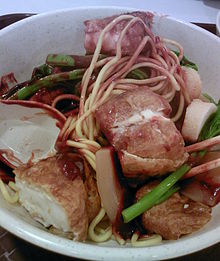 |
|
| Chinese | 釀豆腐 |
| Literal meaning | "stuffed bean curd" |
Nyonya food
China
has always traded with lands near and
far across
the globe. During the Ming Dynasty, as
a diplomatic gesture to strengthen
ties with the rich and strategic port
of
Malacca on the Malayan Peninsula,
the Emperor of China betrothed his
daughter
Princess Hang Li Po to the
Sultan of Malacca.
The royal princess and her entourage of about 500
formed the first permanent Chinese settlement in
Malacca at Bukit China or China
Hill. These early Chinese settlers wed local Malay brides and gave rise to the first generation
of mixed Chinese-Malays known as Peranakan, the male being known as Baba and the
female as Nyonya, pronounced nyoh-nyah and sometimes spelt Nonya.
The term 'Peranakan' originated in Indonesia for the descendants
of immigrant Chinese who had married and integrated with local Indonesians. Akin
to the Peranakan in
Indonesia, these descendents of
mixed Chinese-Malay had forsaken their
Chinese mother tongue and spoke the
local Malay language,
assimilated Malay customs, culture and
dress. Descendants of this early
Peranakan community in Malaysia then married within their own community of
Babas and Nyonyas
establishing a strong hybrid culture
proud of it's heritage.
It was around this era, that the rich
and strategic trading port of
Malacca,
had attracted the
attention of the Portuguese. The strong
naval armada of the Portuguese soon captured Malacca, making it a Portuguese colony for the next 130
years. After Malacca
fell to the Dutch, who took over from the Portuguese as the main European trading power
in the region, the British started exerting their control in the area. In
1786 Sir Francis Light, representing the British East India Company, established
British control of the island of Pinang, now called Penang, and opened the port to trade. The 1824
Anglo-Dutch Treaty with the British ended the Dutch presence on the Malay
Peninsula. Two years later, in 1826, the British East India Company united Penang, Malacca and
Singapore into a British colony, calling it the 'Straits Settlements'. The
rest of the Malayan Peninsula
remained under the control
and rule of the Malay Sultans. Although the first
Peranakan communities first proliferated in Malacca, many Babas and
Nyonyas settled in Penang and Singapore - and therefore - were also called
Straits Chinese.
Since many ancestral customs and traditions of their
Chinese forefathers are still practiced, Babas and Nyonyas
assimilated the local Malay way of life. The Malay language is spoken at home,
though curiously interspersed with
some Chinese dialect. The local Malay attire
sarong kebaya is worn
and many ceremonial traditions,
such as weddings, are
celebrated in traditional Malay custom. This unique marriage of cultures
resulted in
a novel marriage of cuisines, both Chinese and Malay, and is what is now
known
in Malaysia as Nyonya food.
Ketupat
History
It is made from rice that has been wrapped in a woven palm
leaf pouch and boiled. As the rice cooks, the grains expand to fill the
pouch and the rice becomes compressed. This method of cooking gives the
ketupat its characteristic form and texture of a rice dumpling. Ketupat is usually eaten with rendang or served as an accompaniment to satay(chicken or beef or lamb in skewers) or gado-gado (mixed vegetables with peanut sauce).
Local stories passed down through the generations have attributed the
creation of this style of rice preparation to the seafarers' need to
keep cooked rice from spoiling during long sea voyages. The coco leaves
used in wrapping the rice are always shaped into a triangular form and
stored hanging in bunches in the open air. The shape of the package
facilitates moisture to drip away from the cooked rice while the coco
leaves allow the rice to be aerated and at the same time prevent flies
and insects from touching it.
Varieties
There are many varieties of ketupat, with two of the more common ones being ketupat nasi and ketupat pulut. Ketupat nasi is made from white rice and is wrapped in a square shape with coconut palm leaves while ketupat pulut is made from glutinous rice is usually wrapped in a triangular shape using the leaves of the fan palm (Licuala). Ketupat pulut is also called "ketupat daun palas" in Malaysia.
Ketupat is also traditionally served by Malays at open houses on festive occasions such as Idul Fitri (Hari Raya Aidilfitri). During Idul Fitri in Indonesia, ketupat is often served with either opor ayam (chicken in coconut milk), chicken or beef curry, rendang, sambal goreng ati (spicy beef liver), krecek (buffalo or beef skin dish), or sayur labu Siam (chayote soup).
Among the Moro (Muslim) groups of the Philippines, ketupat is served with an array of dishes including tiyulah itum, rendang, ginataang manok, kurma and satay. It is served during special occasions such as Eid'l Fitr, Eid'l Adha and weddings.
Among Christian Filipinos, pusô, as ketupat is locally known,[1][2][3][4] is also traditionally used as a pabaon or a packed lunch, traditionally brought by workers, served with any selection of stews. Pusô is also widely eaten in the side streets of Cebu with pork or chicken skewers and other grilled selections.
plate
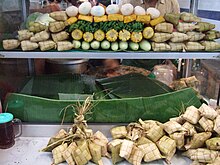
Gado-gado stall displaying the ingredients of the dish, including ketupat
Recommended Bak kut Teh in Klang
Kedai Makanan Seng Huat: Bak Kut Teh (成发肉骨茶) @ Klang
Description
Klang is the popular destination
among diners in the Klang Valley when they fancy having Bak Kut Teh.
Among these popular Bak Kut Teh restaurants is one located under the
Klang bridge. One of the pioneer in selling bak kut teh in Malaysia.
Price
Pork Leg Bak Kut Teh (RM12 per person)
Food
The Bak Kut Teh with Sai Kuat and Pai Kuat, Yau Char Kuay, Loh Tan (Stewed egg), and Tau Foo Pok, Original Bak Kut Teh, Yau Mak
Wantan Mee
This is not the best Wantan Mee in Penang but it is good. Nameless and often referred as the ‘Wantan Mee in front of furniture shop at Chulia Street‘,
the noodles here tastes slightly different from those in Klang Valley.
The noodles are more more springy, tossed with light soy sauce hence the
fairer appearance and has a stronger lard presence. Even the wantan
dumplings look different too, they are so tightly wrapped.

There are alot of stall selling this food. However it is very subjective that which one is more delicious.

There are alot of stall selling this food. However it is very subjective that which one is more delicious.
Roti canai
The roti canai dish
Composition
The dish is composed of dough containing copious amounts of fat, egg, flour and water (although eggless vegan versions do exist). The form of fat used is usually ghee (clarified butter). Some people add sweetened condensed milk to the mix. The entire mixture is kneaded thoroughly, flattened, oiled and folded repeatedly. It is then allowed to proof and rise, and the process is repeated. The final round of preparation consists of flattening the dough ball, coating it with oil and then cooking on a flat iron skillet with a lot of oil. The ideal roti is flat, fluffy on the inside but crispy and flaky on the outside.In Malaysia, roti canai is famous and well organised by indian people.
satay
Satay , is a dish of marinated, skewered and grilled meat, served with a sauce.Satay may consist of diced or sliced chicken, goat, mutton, beef, pork, fish, other meats; the more authentic version uses skewers from the midrib of the coconut palm frond, although bamboo skewers are often used. These are grilled or barbecued over a wood or charcoal fire, then served with various spicy seasonings.
Satay originated in Java, Indonesia. Satay is available almost anywhere in Indonesia, where it has become a national dish. It is also popular in many other Southeast Asian countries, such as: Malaysia, Singapore, Brunei, Thailand as well as in the Netherlands, as Indonesia is a former Dutch colony.
Satay is a very popular delicacy in Indonesia; Indonesia's diverse ethnic groups' culinary arts (see Indonesian cuisine) have produced a wide variety of satays. In Indonesia, satay can be obtained from a travelling satay vendor, from a street-side tent-restaurant, in an upper-class restaurant, or during traditional celebration feasts. In Malaysia, satay is a popular dish—especially during celebrations—and can be found throughout the country.
Satay Receipe!
Chinese dumpling
Chinese cuisine (Dumpling)

A plate of guotie.

A dumpling filling consisting of minced chicken and spring onion.
If dumplings are laid flatly on a pan, first steamed with a lid on and with a thin layer of water, then fried in oil after the water has been evaporated, they are called guotie or as the Maillard reaction occurring on the bottom of the dumpling make the skin crispy and brown. The same dumplings are called jiaozi if they are plainly steamed.
The wonton ) is another kind of dumpling. It is typically boiled in a light broth or soup and made with a meatier filling. The skin wrapping for wontons is different—thinner and less elastic—than that used for jiaozi[citation needed]. Wontons are more popular in Southern China (Shanghai, Guangdong, Hong Kong etc.) whereas in Northern China, jiaozi are more popular. Jiaozi, wonton and potstickers are all wrapped differently.
Another type of Chinese dumpling is made with glutinous rice. Usually, the glutinous rice dumplings 粽子 zongzi are triangle or cone shaped, can be filled with red bean paste, Chinese dates or cured meat depending on region. Glutinous rice dumplings are traditionally eaten during the Duanwu Festival.
Chinese cuisine includes sweet dumplings. Tangyuan are smaller dumplings made with glutinous rice flour and filled with sweet sesame, peanut, red bean paste. Tangyuan may also be served without a filling. Tangyuan are eaten on the 15th day of Chinese New Year, or the Lantern Festival. There are also other kinds of dumplings such as har kao, siew mai, small cage-steamed bun (xiaolongbao), pork bun and crystal dumpling.
See also: dim sum 点心 for descriptions of several other kinds of dumplings such as gau and taro root dumplings.
Nasi Lemak
Nasi lemak is a fragrant rice dish cooked in coconut milk and "pandan" leaf commonly found in Malaysia, Brunei, Singapore, Riau Islands and Southern Thailand. Malaysia proclaims it its national dish and a national heritage of Malaysia, although it's widely served in other parts of the region. It is not to be confused with Nasi Dagang sold on the east coast of Malaysia or Terengganu and Kelantan
although both dishes can usually be found sold side by side for
breakfast. However, because of the nasi lemak's versatility in being
able to be served in a variety of manners, it is now served and eaten
any time of the day.
With roots in Malay culture and Malay cuisine, its name in Malay
literally means "fatty rice", but is taken in this context to mean
"rich" or "creamy". The name is derived from the cooking process whereby
rice is soaked in coconut cream and then the mixture steamed. This is the same process used to make a dish from their neighboring country, Indonesia, which is nasi uduk, therefore the two dishes are quite similar. Sometimes knotted screwpine leaves are thrown into the rice while steaming to give it more fragrance. Spices such as ginger and occasionally herbs like lemon grass may be added for additional fragrance.
Traditionally, this comes as a platter of food wrapped in banana leaves, with cucumber slices, small fried anchovies (ikan bilis), roasted peanuts, hard boiled egg, and hot spicy sauce (sambal) at its core. As a more substantial meal, nasi lemak can also come with a variety of other accompaniments such as ayam goreng (fried chicken), sambal sotong (cuttlefish in chilli), cockles, stir fried water convolvulus (, pickled vegetables , beef (beef stewed in coconut milk and spices) or paru (beef lungs). Traditionally most of these accompaniments are spicy in nature.
Nasi lemak is widely eaten in Malaysia and Singapore, even as a dish
served in Malaysian schools. Commonly a breakfast dish in both
countries, it is normally sold at hawker food centres in Singapore and
roadside stalls in Malaysia. It often comes wrapped in banana leaves,
newspaper or brown paper,and it could be served on a plate. However,
there are restaurants which serve it as a noon or evening meals, making
it possible for the dish to be eaten all day. Nasi lemak kukus which means "steamed nasi lemak" is another name given to nasi lemak served with steamed rice.
Wednesday, May 16, 2012
Laksa
Laksa is a popular spicy noodle soup from the Peranakan culture, which is a merger of Chinese and Malay elements found in Malaysia and Singapore, and to a lesser extent, Indonesia.
There are two basic types of laksa: curry laksa and asam laksa. Curry laksa is a coconut curry soup with noodles, while asam laksa is a sour fish soup with noodles. Thick rice noodles also known as laksa noodles are most commonly used, although thin rice vermicelli (bee hoon or mee hoon) are also common and some variants use other types
Curry laksa
Curry laksa (in many places referred to simply as “laksa”) is a
coconut-based curry soup. The main ingredients for most versions of
curry laksa include bean curd puffs, fish sticks, shrimp and cockles. Some vendors may sell chicken laksa. Laksa is commonly served with a spoonful of sambal chilli paste and garnished with Vietnamese coriander, or laksa leaf, which is known in Malay as daun kesum.
This is usually known as Curry Mee in Penang rather than curry laksa, due to the different kind of noodles used (yellow mee or bee hoon, as opposed to the thick white laksa noodles). Curry Mee in Penang uses congealed pork blood, a delicacy to the Malaysian Chinese community. Two of the well known places to try curry mee is at Lorong Seratus Tahun and Chulia Street.[citation needed]
The term "Curry laksa" is more commonly used in Kuala Lumpur or Singapore. Laksa is popular in Singapore and Malaysia, as are laksa yong tau foo, lobster laksa, and even plain laksa, with just noodles and gravy.
Variants of curry laksa include:
- Laksa lemak, also known as nyonya laksa (Malay: Laksa nyonya), is a type of laksa with a rich coconut gravy. Lemak is a culinary description in the Malay language which specifically refers to the presence of coconut milk which adds a distinctive richness to a dish. As the name implies, it is made with a rich, slightly sweet and strongly spiced coconut gravy. Laksa lemak is usually made with a fish-based gravy (with vegetarian food stalls omitting fish) and is heavily influenced by Thai laksa (Malay: Laksa Thai), perhaps to the point that one could say they are one and the same.
- Laksam, a speciality of the Northeastern Malaysian states of Kelantan, Terengganu and Kedah, is made with very thick flat white rice flour noodles in a rich, full-bodied white gravy of boiled fish and coconut milk. Though usually made of fish flesh, it is sometimes made with eels. Traditionally laksam is eaten with hands rather than with eating utensils due to the gravy's thick consistency
- Katong laksa (Malay: Laksa Katong) is a variant of laksa lemak from the Katong area of Singapore.
In Katong laksa, the noodles are normally cut up into smaller pieces so
that the entire dish can be eaten with a spoon alone (that is, without
chopsticks or a fork). Katong laksa is a strong contender for the
heavily competed title of Singapore's national dish.
Asam laksa
Asam laksa is a sour, fish-based soup. It is listed at number 7 on World's 50 most delicious foods complied by CNN Go in 2011.Asam (or asam jawa) is the Malay word for tamarind, which is commonly used to give the stock its sour flavor. It is also common to use asam keping (also known as asam gelugor), dried slices of sour mangosteen, for added sourness. The modern Malay spelling is asam, though the spelling assam is still frequently used.The main ingredients for asam laksa include shredded fish, normally kembung fish or mackerel, and finely sliced vegetables including cucumber, onions, red chillies, pineapple, lettuce, common mint, "daun kesum" (Vietnamese mint or laksa mint) and pink bunga kantan (ginger buds). Asam laksa is normally served with either thick rice noodles or thin rice noodles. And topped off with "petis udang" or "hae ko" , a thick sweet prawn.
Variants of asam laksa include:
- Penang laksa (Malay: Laksa Pulau Pinang), also known as asam laksa from the Malay for tamarind, comes from the Malaysian island of Penang. It is made with mackerel (ikan kembung) soup and its main distinguishing feature is the asam or tamarind which gives the soup a sour taste. The fish is poached and then flaked. Other ingredients that give Penang laksa its distinctive flavour include lemongrass, galangal (lengkuas) and chilli. Typical garnishes include mint, pineapple slices, thinly sliced onion, hε-ko, a thick sweet prawn paste and use of torch ginger flower. This, and not 'curry mee' is the usual 'laksa' one gets in Penang.
- Perlis laksa (Malay: Laksa Perlis) is similar to Penang Laksa but differs in garnishing used such as catfish and eel fish. The famous Perlis laksa can be found in Kuala Perlis.
- Kedah laksa (Malay: Laksa Kedah) is very similar to Penang laksa and only differs in the garnishing used. Sliced boiled eggs are usually added to the dish. Kedah laksa used rice to make a laksa noodle. The famous laksa in Kedah is Laksa Telok Kechai.
- Ipoh laksa (Malay: Laksa Ipoh), from the Malaysian city of Ipoh, is similar to Penang laksa but has a more sour (rather than sweet) taste, and contains prawn paste.
- Kuala Kangsar Laksa (Malay: Laksa Kuala Kangsar), made of wheat flour (usually hand made). The soup is rather lighter than the common laksa taste and so much different from Ipoh Laksa in shape, taste and smell. The local municipal council even built a complex called "Kompleks Cendol dan Laksa" near the river bank of the Perak River. It is the main attraction for tourists in Kuala Kangsar
Here is the receipe to prepare laksa
Food Screening
Today, I would like to share this video in the very beginning with you all. This is because this video generally explain most of the famous food in Malaysia and is in the top list of the food that must try when you in Malaysia.
Enjoy!
What do you feel after viewing this video clip? Feel hungry? Delicous?
If yes, do visit and stay tune with my introduction on more food and some receipe that allowed you to even cook yourself at home.
Enjoy!
What do you feel after viewing this video clip? Feel hungry? Delicous?
If yes, do visit and stay tune with my introduction on more food and some receipe that allowed you to even cook yourself at home.
The Introduction
Malaysia is a awesome place in which there are different races living together. This gather the traditional cuisine from Chinese, Malay and Indian. Generally, the food shows and represent the background of one culture and the taste of their life respectively.
Especially, Penang, which is a food paradise in Malaysia as well as is well known thoughtout the world. Tourist normally visit Malaysia for food besides for historical tourismn.
Annually, Malaysia will conduct a Food Carnival gathering all sorts of food throughout the states and this gives chance to everyone to try out food.
Especially, Penang, which is a food paradise in Malaysia as well as is well known thoughtout the world. Tourist normally visit Malaysia for food besides for historical tourismn.
Annually, Malaysia will conduct a Food Carnival gathering all sorts of food throughout the states and this gives chance to everyone to try out food.
Thursday, May 3, 2012
Monday, April 30, 2012
开学了
你们都应该知道,现在我要说什么吧?
享受了3个星期的假期,是时候回到现实世界
开始了我的第三学期。
明天就要回到KL,后天就要开学了。
好快,时间过得好快
尤其是,快乐的时光。
我知道,我会想家。
毕竟,我又习惯了在家乡的生活
突然,要我会到KL,老实说会有点不习惯
不过不要紧,我知道接下来的忙碌生活,
会让我不知时间天日。
开学了,读书的心要回来了。
要加油!继续往目标前进!
期待下一个假期! =)
享受了3个星期的假期,是时候回到现实世界
开始了我的第三学期。
明天就要回到KL,后天就要开学了。
好快,时间过得好快
尤其是,快乐的时光。
我知道,我会想家。
毕竟,我又习惯了在家乡的生活
突然,要我会到KL,老实说会有点不习惯
不过不要紧,我知道接下来的忙碌生活,
会让我不知时间天日。
开学了,读书的心要回来了。
要加油!继续往目标前进!
期待下一个假期! =)
Wednesday, April 25, 2012
First Semester trip ^^
很开心的说,我大学的第一个semester break trip,是我家乡槟城。
我也很开心的,当起了地主之谊 ^^
这趟4天5夜的快乐旅途,真的为我们的大学生涯写下一篇不灭的一页。=)
第一天(4月14日)
他们下午抵补,休息了一会儿就首先带她们参观蛇庙。
而且,这一次是我第一次驾车载朋友们呢!
Group photo #1
过后,我们去吃自助火锅 (火锅之家)
我的父母和我一起吃,但当他们回过后,我们开始疯狂的拍起照来 XD
你看我们几可爱,几鬼马 ...
扮鬼脸 #1
其实还有很多很可爱的照片,但是太多了,upload不完。哈哈哈
晚饭后,我们去了straits quay。他们看到了straits quay,惊叹不已,狂赞美丽。
group photo #2
Group Photo #3
这个晚上,我们去看了半夜场 (小孩不坏)。。 晚上12.30开场,戏结束时已经3am了。
哈哈。。。。很不错的经验,而且我还是第一次看半夜场叻。
第二天 (4月15日)
早上我们去参观了极乐寺。
Group Photo #4
当然,带了他们去吃山脚下远近驰名的laksa咯。
然后,想必大家都太累了,回家午睡了一下,比原定时间迟了一小时出门。
出发前往高渊的观赏萤火虫......
Group Photo #5
me & yee ying :)
我们的晚餐,是美味可口而且他们都赞既便宜,有好吃的海鲜。
第三天 (4月16日)
这个凌晨,很开心,他们很惊喜的躲在我房间,为我唱生日歌 :)
隔日早晨,我们去Neway唱 K。因为我们人多,他们给我们VIP room。
哇!很豪华,很大,很享受。
别看我们平时,只会读书,但原来卧虎藏龙。。。。
(".")V yeah~
原来,还有惊喜哦!你看,是Tom & Jerry 的 cup cakes!
Thank you dears!
第四天 (4月17日)
本来是第二天的行程,就过拖到第四天。哈哈
原因是我们晚上不睡觉,早上才爬不起。LOL
Group Photo #6
然后,我们就驱车上Batu Ferringgi 的 Hard Rock Hotel beach 看日落。
日落前 ,当然是拍照啦!
=)
 |
| 我们最爱扮鬼脸! |
算是最成功的一张了
 |
| Group Photo #7 |
 |
| 这些足印,希望你们永远都记得,这是我们曾经的回忆。 =) |
希望你们会满意这一次的旅行。
那不眠的夜晚,那诉谈倾心的谈话,那欢乐的笑声,那珍惜的友谊,
你们写下了我大学生涯中,美好的回忆。 =)
Subscribe to:
Posts (Atom)




